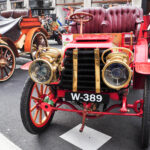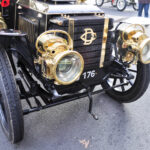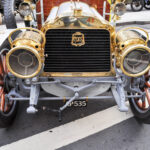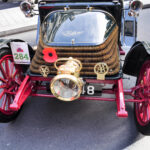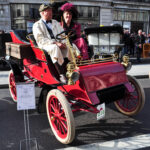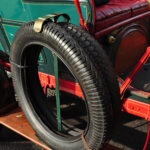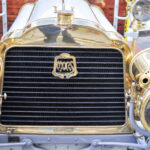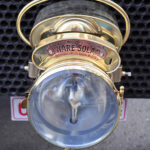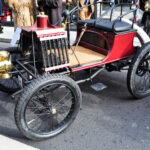(Part one of the 2015 Regent Street Motor Show is <a ” href=”http://www.cumbriancarnut.com/regent-street-motor-show-sat-31st-oct-2015-part-1/#more-3672″>here).
It’s not often that you get a chance to get so close to such historic vehicles and their custodians. I lie – you can do it every year on Regent Street and in Hyde Park in early November!
This is my second post covering the Regent Street Motor Show and this one focuses on more of the veteran cars that were on display ahead of the 2015 running of the annual London to Brighton Run for pre-1905 cars.
“Doe Ray Me Phare Solar Tea Doe”
“Doe a deer – a female deer……………Ray – a drop of golden sun………….Me – a name I call myself…………..Phare Solar – a brass acetylene headlamp fitted to a 1904 Rambler!”
Apologies to Sound of Music fans – Edwardian or Brass Era cars are renowned for their wealth of brass fixtures and fittings – most especially their brass acetylene headlamps.
These lovely devices warrant close scrutiny to reveal the great workmanship that went into them. I assume it was a French manufacturer that first adopted the name “Phare” (French for lighthouse) for these new-fangled car headlamps but it was nice that Belgian and even US manufacturers perpetuated the use of “Phare” for their own headlamp models.
From what I saw on display in Regent Street – Phare Ducellier of Paris seemed to be the most commonly used headlight. Phare Willocq Bottin of Brussels was a new one for me and I did spot one early British Lucas King of the Road but I particularly liked the Phare Solar of extremely un-French Badger Brass Mfg. Co. of Kenosha, Wisconsin!
Veteran Cars – F to W
I’ve been thinking about these veteran cars and it struck me that their annual turn-out for the Regent Street Motor Show and for the subsequent London To Brighton Run is akin to an automotive Gene Bank or Biorepository annually throwing open its doors for the weekend.
Because these cars go back to the dawn of motoring they represent the genetic base from which modern cars have sprung. Examining these cars closely shows features and developments not reached through natural mutation but instead by ingenious experimentation. Whilst Darwinian theory in the form of “survival of the fittest” has consigned some ancient features to history – others have thrived but some seemingly obsolete features have gone through regular re-valuation by more recent automotive innovators.
A couple of veteran cars for example had hefty flywheels and flywheel technology has recently been re-examined by a number of leading manufacturers as a more efficient kinetic energy recovery system (KERS) than more conventional battery based hybrids.
In 2010 – Porsche developed their 911 GT3 RS Hybrid followed in 2011 by Jaguar’s XF Flywheel Hybrid and most spectacularly in 20012 Audi won the Le Mans 24 Hour Race with their R18 e-tron Quattro with flywheel technology. Formula One teams also used Torotrak “Flybrid” KERS devices during the 2009 season. Away from the race track – Volvo are working closely with Flybrid Automotive to develop systems for deployment in their road cars to radically reduce petrol consumption.
So in short – my premise is that the veteran, vintage and classic cars of any age are not just quaint looking museum pieces that need to be preserved in aspic. They are living breathing ongoing experiments which still offer glimpses of our automotive future!
Following on from Regent Street Motor Show – 31st Oct 2015 Part 1 – here are some more of the veteran ongoing experiments that caught my eye:-
Fiat
Societa Anonima Fabbrica Italiana Automobili Torino (aka F.I.A.T. simplified later to Fiat) was founded in 1899 in Turin (the clue is in the name). One particularly innovative member of the founding board of directors – Giovanni Agnelli beceme Managing Director in 1902 and this established the Agnelli dynasty, an automotive aristocracy that ruled the Fiat conglomerate until the death of Gianni Agnelli (Giovanni’s grandson) in 2003.
Fiat car production kicked off in 1899 with the 3.5HP CV. This was followed by a 6HP car in 1900, a 10HP car in 1901 and so on to 1905 when the Fiat 240-320hp cars were created. Fiats were successfully raced in the very first race events to be run in Italy and a Fiat actually won the first running of the Car Tour of Italy. Giovanni Agnelli himself raced an 8HP model in the second Car Tour of Italy setting a record in the process. Racing innovation was used to directly benefit road car development.
From 1904 Fiat race car engines went from 10.6 Litre four-cylinder with inlet valves over exhaust to 16.3 Litres (in 1904 & 1905) with overhead valves to 15.3 Litres. This constant search for more power and speed helped the Fiat race cars secure important victories in Grand Prix and road races such as the Targa Florio of the period.
The handsome Fiat pictured below is a 1904 four-cylinder 40hp car.
Ford
Ford Motor Company as we know it today was actually Henry Ford’s third attempt at founding and running a car manufacturing company.
With encouragement from his then employer Thomas Alva Edison – Ford secured financial backing to found his first car manufacturing company – the Detroit Automobile Company in 1899. The cars proved to be unsuccessful and the company was dissolved after just 18 months in January 1901.
After some success racing a new prototype car – Ford’s second attempt – the eponymously named Henry Ford Company was founded in 1901 but after a dispute with the investors Ford left the company and the its name was changed to Cadillac with another Henry (Henry M. Leland) coming in to replace Ford as Chief Engineer.
Third time lucky – Ford Motor Company was founded in June 1903 after some rather brilliant promotion of Ford’s latest car design. This included Henry Ford himself setting a new land speed record in one of his creations. Over the next few years the company continued to establish the Ford brand laying the foundations for the launch of the record breaking Model T Ford in 1908. The rest as they say is history.
A number of early Ford models were on display including the Rear Entry Tonneau models picture below from 1903 and 1904. These cars obviously predate Henry Ford’s Model T era predilection for universally black colour schemes!
Isotta Fraschini
Societa Milanese Automobili Isotta Fraschini & C. was founded in 1900 by Cesare Isotta and the the brothers Fraschini – Vincenzo, Antonio and Oreste.
Early cars were based very much around Renault design technology but from 1905 the Italian marque very much ploughed its own design furrow through the leadership of Giustino Cattaneo.
Isotta Frashini cars were enthusiastically and successfully raced and this led to them developing such innovations as overhead cam engines to deliver increased performance. Isotta Fraschini were also early adopters of the Arrol-Johnston invented 4 wheel brake system.
The company grew to take on the manufacture of trucks and also engines for use in marine and aviation applications but became most famously renowned for their luxury cars which became the transport of choice for American film stars, plutocrats, and gangsters in the ’20s and ’30s.
A 1929 Isotta Fraschini 8A featured in the film Sunset Boulevard – supposedly driven by Norma Desmond’s butler Max von Mayerling – a character played by Erich von Stroheim. In reality – von Stroheim couldn’t drive, so the driving scenes had to mocked-up!
To mark the 30th anniversary of Isotta Fraschini in 1931 the car pictured below was gifted at the insistence of Mussolini to the Ford Museum in Dearborn. Anticipating receipt of a luxurious 8 cylinder 1930’s model the museum was surprised to receive this car – the first ever constructed by Isotta Fraschini in 1901.
The sympathetic partial reconstruction of this car including a perspex floor to clearly show its working parts generated much interest and did not prevent its participation in the London to Brighton run.
Maxwell
Maxwell was a US based manufacturer operating between 1904 and 1925 before being subsumed into Chrysler.
After leaving Oldsmobile – Jonathan Dixon Maxwell linked up with Benjamin Briscoe of Briscoe Brothers Metalworks to establish Maxwell-Briscoe Company in Tarrytown, New York.
This Model H car dates was the 69th Maxwell built and it features a 3.75 Litre two-cylinder 16HP engine and innovative side-entry doors.
Mors
Founded in 1897 in France by Emile Mors this company along with Panhard et Levassor were the pioneers of early motor racing. Mors racing cars were in fact instrumental in breaking Panhard’s stranglehold on the early racing scene.
Their enthusiastic involvement in racing enabled Mors to experiment with a number of innovations including the first ever V configuration engines (a V-4) in 1898.
The mighty 7.3 Litre 24HP Mors of 1900 won the Bordeaux-Perigueux-Bordeaux race and the Paris-Toulouse-Paris races. The following year – Mors raced an even more powerful 10.1 Litre 60HP car successfully in the Paris-Bordeaux and Paris-Berlin races.
In 1902 the Mors race car ran a 9.2 Litre engine and the car also featured highly innovative pneumatic shock absorbers.
Andre Citroen became associated with Mors as their chairman in 1908 and Mors was eventually absorbed into Citroen in 1925 at which point the marque and its wonderful Art Nouveau badge disappeared for ever.
Oldsmobile
Strictly speaking Oldsmobile was an adopted nickname for the Olds Motor Vehicle Co. founded in 1897 in Lansing, Michigan by Ransom E. Olds. In the early 1900s it was the top selling US car manufacturer.
Interestingly the Curved Dash model pictured below was the first mass produced car made on an assembly line. Henry Ford later went one better by introducing the concept of a moving assembly line.
These elegant little cars with their tiller steering look more like horse-drawn coaches than cars but they remain a popular and reliable entrant in the London too Brighton run.
Packard
Packard was founded in Warren, Ohio in 1899 by brothers James Ward and William Packard along with George Lewis Weiss. Full blown car production didn’t kick off until 1900 through the services of the Ohio Automobile Company which eventually changed its name to the Packard Motor Car Company in 1902 – at the same time the factory moved to Detroit.
Early Packards (including the one pictured below) were single cylinder cars but the number of cylinders increased after 1903 and eventually this trend for increasing the number of cylinders delivered the very first twelve-cylinder engined car.
Packard steadily moved up the value chain and it’s luxury cars of the ’20s and ’30s were in great demand around the world.
The very early car pictured below featured modern components such as a conventional steering wheel.
Pierce
Pierce Arrow Motor Car Company was in existence from 1901 to 1938 in Buffalo, New York. Founded by George Norman Pierce the company moved on from an abortive attempt to build a steam car to building single cylinder Motorettes before moving onto produce the twin cylinder Arrow in 1903.
Pierce went on to build ever bigger, more powerful and more luxurious cars which became the vehicle of choice for a number of the Hollywood gliterati.
Pope
Founded by the grandly named Albert Augustus Pope out of his highly successful Pope Manufacturing Company of Hartford, Connecticut this car company again originated from bicycle manufacture (in this case Columbia).
From 1897 Pope built electric cars but eventually moved into internal combustion engined cars from 1903 with the Pope-Hartford, Tribune, Toledo, Robinson and Waverly sub-companies Examples of the Hartford and Tribune can be seen below.
During their electric car period – Pope’s chief engineer was Hiram Percy Maxim the son of Hiram Stevens Maxim who developed the Maxim Gun in a factory in Hatton Garden, London.
Rambler
Sometimes known as the “Konesha Cadillac” Rambler under the ownership of the Thomas B. Jeffrey Company built cars between 1900 and 1914 before being taken over by Nash Motors.
Like a number of early car manufacturers – Rambler was spawned from earlier bicycle manufacturing business run by Thomas Jeffrey in Chicago.
His Rambler car factory took over another old bicycle factory (Sterling) in Kenosha, Wisconsin and mass production was in full swing by 1902 introducing such innovations as the steering wheel and complete spare wheel with tyre to the motoring public.
The Covered Tonneau two-cylinder 10HP car from 1904 pictured below sported a single, centrally mounted brass acetylene lamp which upon close examination was also made in Kenosha by the Badger Brass Mfg. Co.
Renault
Societe Renault Freres corporation was founded by Louis, Marcel and Fernand Renault in 1899. It was Louis who led on the design and build of Renault cars with louis and Marcel focussing on the business side of the company.
The first Renault badged car produced was the Renault Voiturette 1CV which pre-dated the establishment of the parent company. One particular feature which made Renault cars stand out from their contemporaries was the use of shaft drive rather than the almost ubiquitous chain drive adopted from bicycle and motorcycle design or the other alternative – belt drive!
Car manufacture progressed apace using engines supplied by Aster or De Dion Bouton but in 1903 Renault started to build and use its own engines designed by Monsieur Viet (a former employee of De Dion Bouton).
Louis and Marcel Renault successfully raced their cars and Marcel achieved one especially notable win in the Paris-Vienna race in which he drove his little Renault Voiturette to victory a full 45 minutes ahead of the chasing much larger cars (including Count Eliot Zborowski in a Mercedes). Sadly Marcel was killed during the subsequent Parid-Madrid race and Renault’s racing efforts were restricted until their re-emergence in Grand Prix racing in 1906.
Setting rise their race successes – what really put Renault on the map was the clinching of a major deal in 1905 to adopt Renault AG1 cars as the taxi car of choice across France and in 1907 – this deal also extended to London.
From 1906 – Renault expanded into the production of commercial vehicles the company has continued to thrive since.
There were some lovely Renaults on display – most with the typical Renault sloping and slatted front radiator cowl which was probably as familiar to people hailing a taxi in early 1900’s London as black cabs are today.
Stevens-Duryea
Founded through a link-up between J. Frank Duryea’s Hamden Automobile and Launch Company and J. Stevens Arms and Tool Company in 1901 in Chicopee Falls, Massachusetts produced a range of twin-cylinder cars.
The car is an early 1903 Model L Stanhope with a 2 cylinder (horizontally opposed) 7HP engine.
Westfield
Westfield cars were manufactured by C. J. Moore Mfg. Co. between 1902 and 1903 in Westfield, Massachussets.
They were arguably an early example of kit car manufacturers as they sold body/chassis units for buyers to fit their steam or internal combustion engine of choice. This was reflected in their advertising slogan “Complete Automobiles Ready For Power – Finished or Unfinished”!
Fully finished cars were sold under the Westfield brand name and a beautiful example of one of these – a 1902 Rear Entrance Tonneau with two cylinders and 13HP is pictured below. This is the only surviving example of the marque and is looking fantastic after a $400,000 restoration.
White
White steam cars came out of Thomas H. White’s White Sewing Machine Company. After dabbling with semi-flash boilers in 1890 – White’s sons diverted the company away from sewing machines and towards steam car manufacture and their first steam cars were constructed in 1900.
Early cars were carriage like vehicles with tiller steering and under-floor engines but these evolved through 1902 and 1903 to more conventional looking cars like the one below with front engine, front windscreen, conventional steering wheel and cabin with a roof.
I’ve always thought that the incredibly high roofline of this particular White is designed to easily accommodate gentlemen wearing stovepipe hats or ladies sporting towering hair styles. I just can’t help visualising Abraham Lincoln driving one with Isambard Kingdom Brunel alongside him and Marge Simpson in the back seat!
End of Part 2
Related Posts
Regent Street Motor Show – Sat 31st Oct 2015 Part 1
London To Brighton Run – Sun 2nd Nov 2014
Regent Street Motor Show – Sat 1st Nov 2014
Regent Street Motor Show – Sat 2nd Nov 2013




